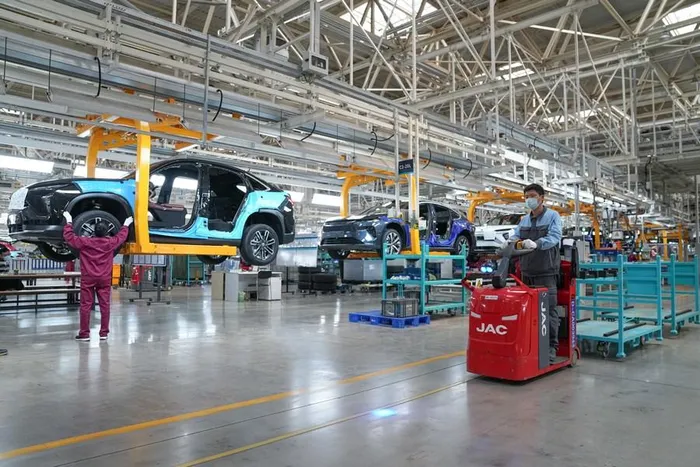Global Manufacturing in Q2 2025: Growth, Divergence, and Underlying Risks

Technicians work on a vehicle production line at the NIO manufacturing base in Hefei, east China's Anhui Province.
Image: Xinhua
In the second quarter of 2025, the global manufacturing sector demonstrated notable resilience. According to UNIDO, manufacturing production rose by 1.1%, marking the fifth consecutive quarter of positive growth despite headwinds from trade tensions, supply chain disruptions, and geopolitical uncertainty. While advanced (industrial) economies sustained stronger momentum, industrializing economies posted more modest gains of around 0.8% growth.
Sectoral Drivers: High-Tech Leads, Low-Tech Lags
Growth was uneven across sectors. Medium-high and high-tech industries, especially electronics and transport equipment, saw the strongest expansion. In many advanced nations, ongoing defense spending and demand for high-spec capital goods contributed significantly. Meanwhile, lower-tech manufacturing segments remained flat or only marginally positive, underscoring a widening performance gap across the industrial value chain.
Complementing production, global manufacturing trade surged by 4.1%, its fastest quarterly advance since 2021. High-tech exports outpaced overall growth with a 4.4% rise, driven especially by Europe and Asia–Oceania (excluding China). In contrast, some regions, such as North America, recorded a reduction in their manufactured goods trade deficit—potentially reflecting the interplay of tariff adjustments and reciprocal trade responses.
This sharp divergence between production (up 1.1%) and exports (up 4.1%) is striking. In Europe, for example, exports grew by 6.5% in Q2 even while manufacturing output was relatively stagnant—a signal that demand from abroad may increasingly be decoupled from domestic capacity. Asia and Oceania, by contrast, showed more synchronized growth in production and exports, reflecting stronger internal industrial performance.
Trade in Capital Goods & Technology Intensity
A deeper look at capital goods trade reveals differentiated trends. At constant prices, exports of investment goods globally grew about 4.5% year-on-year in Q2 2025, matching the pace of Q1 and accelerating relative to 2024 averages. Within that, sectors such as industrial machinery, electrotechnical equipment, and ICT-related tools recorded double-digit gains. For instance, exports of industrial machinery expanded by +8.2%, and electrotechnical engineering products surged by +8.3%. Agricultural machinery, however, showed persistent weakness.
These patterns reinforce a broader structural shift: the premium is increasingly on technological complexity, not scale alone. Regions that can move up the value chain—toward machinery, electronics, and innovation-intensive production—are best positioned to capture trade and investment gains.
Risks, Tensions, and Structural Frictions
The positive headline masks sharp challenges and vulnerabilities:
Trade policy tensions and tariffs continue to distort incentives. In the U.S., for example, recent tariff measures on steel and aluminum, as well as “reciprocal tariffs,” may be influencing the narrowing of North America’s manufactured goods deficit.
Supply chain delays remain a persistent drag. Rising lead times and disruptions force firms to carry higher inventories—raising costs and reducing agility. One recent analysis estimates that delivery delays alone may have cut output by ~2.6% and raised prices by ~0.4% in recent years.
Uneven regional performance adds political and strategic risk. Europe’s export strength despite weak production suggests dependence on external demand; a global downturn could expose fragility. Meanwhile, regions more reliant on low-tech production remain vulnerable to shifts in global demand or replacement by automation.
Structural constraints in developing economies—including limited access to capital, weak institutions, and skills gaps—may limit how far they can benefit from global trends.
Implications & Forward Paths
The Q2 2025 data offer both encouragement and caution. From these insights, several strategic priorities emerge:
Cultivate technological upgrading
Policymakers and industry leaders should incentivize advances in high-tech manufacturing and complex capital goods—not just expansion in low-value segments.
Promote export-led industrialization
Given the divergence between production and trade, linking domestic manufacturing more deliberately to global value chains is essential. That means boosting quality, reducing non-tariff barriers, and supporting trade logistics.
Strengthen resilience in supply chains
Investments in logistics, diversification of suppliers, and digital traceability systems can mitigate the drag of delays and disruptions.
Balance trade policy with strategic openness
Tariff measures should be carefully calibrated to protect sensitive industries, not to suffocate integration into global markets. Reciprocal or retaliatory trade responses need nuance.
Close institutional and capability gaps
For industrialising economies, addressing capital constraints, reinforcing governance, and building human capital are sine qua nons for inclusive growth.
As we move into H2 2025, the trajectory of global manufacturing will hinge not merely on demand cycles, but on which economies can navigate complexity, absorb shocks, and decisively pivot toward innovation-led growth. If Q2 was any indication, the gap between “growth” and “sustainable industrial development” is widening—but not yet insurmountable.
Written By:
Chloe Maluleke
Associate at BRICS+ Consulting Group
Russian & Middle Eastern Specialist
** MORE ARTICLES ON OUR WEBSITE https://bricscg.com/
** Follow https://x.com/brics_daily on X/Twitter for daily BRICS+ updates